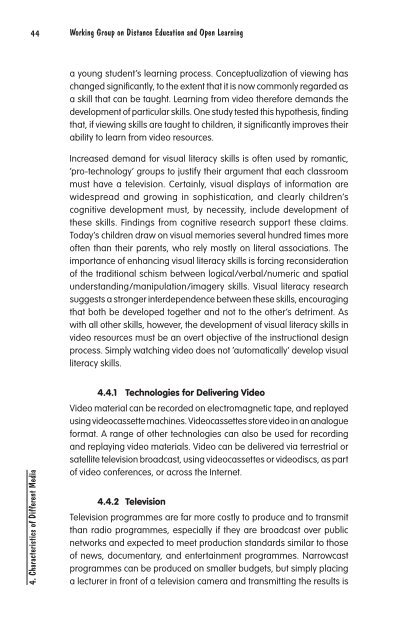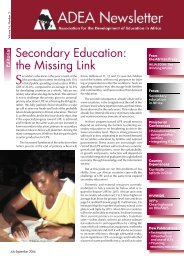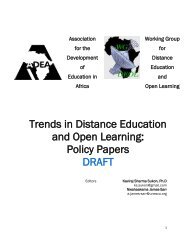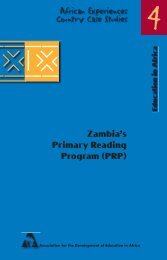Technological Infrastructure and Use of ICT in Education in ... - ADEA
Technological Infrastructure and Use of ICT in Education in ... - ADEA
Technological Infrastructure and Use of ICT in Education in ... - ADEA
You also want an ePaper? Increase the reach of your titles
YUMPU automatically turns print PDFs into web optimized ePapers that Google loves.
44 Work<strong>in</strong>g Group on Distance <strong>Education</strong> <strong>and</strong> Open Learn<strong>in</strong>g<br />
a young student’s learn<strong>in</strong>g process. Conceptualization <strong>of</strong> view<strong>in</strong>g has<br />
changed significantly, to the extent that it is now commonly regarded as<br />
a skill that can be taught. Learn<strong>in</strong>g from video therefore dem<strong>and</strong>s the<br />
development <strong>of</strong> particular skills. One study tested this hypothesis, f<strong>in</strong>d<strong>in</strong>g<br />
that, if view<strong>in</strong>g skills are taught to children, it significantly improves their<br />
ability to learn from video resources.<br />
Increased dem<strong>and</strong> for visual literacy skills is <strong>of</strong>ten used by romantic,<br />
‘pro-technology’ groups to justify their argument that each classroom<br />
must have a television. Certa<strong>in</strong>ly, visual displays <strong>of</strong> <strong>in</strong>formation are<br />
widespread <strong>and</strong> grow<strong>in</strong>g <strong>in</strong> sophistication, <strong>and</strong> clearly children’s<br />
cognitive development must, by necessity, <strong>in</strong>clude development <strong>of</strong><br />
these skills. F<strong>in</strong>d<strong>in</strong>gs from cognitive research support these claims.<br />
Today’s children draw on visual memories several hundred times more<br />
<strong>of</strong>ten than their parents, who rely mostly on literal associations. The<br />
importance <strong>of</strong> enhanc<strong>in</strong>g visual literacy skills is forc<strong>in</strong>g reconsideration<br />
<strong>of</strong> the traditional schism between logical/verbal/numeric <strong>and</strong> spatial<br />
underst<strong>and</strong><strong>in</strong>g/manipulation/imagery skills. Visual literacy research<br />
suggests a stronger <strong>in</strong>terdependence between these skills, encourag<strong>in</strong>g<br />
that both be developed together <strong>and</strong> not to the other’s detriment. As<br />
with all other skills, however, the development <strong>of</strong> visual literacy skills <strong>in</strong><br />
video resources must be an overt objective <strong>of</strong> the <strong>in</strong>structional design<br />
process. Simply watch<strong>in</strong>g video does not ‘automatically’ develop visual<br />
literacy skills.<br />
4. Characteristics <strong>of</strong> Different Media<br />
4.4.1 Technologies for Deliver<strong>in</strong>g Video<br />
Video material can be recorded on electromagnetic tape, <strong>and</strong> replayed<br />
us<strong>in</strong>g videocassette mach<strong>in</strong>es. Videocassettes store video <strong>in</strong> an analogue<br />
format. A range <strong>of</strong> other technologies can also be used for record<strong>in</strong>g<br />
<strong>and</strong> replay<strong>in</strong>g video materials. Video can be delivered via terrestrial or<br />
satellite television broadcast, us<strong>in</strong>g videocassettes or videodiscs, as part<br />
<strong>of</strong> video conferences, or across the Internet.<br />
4.4.2 Television<br />
Television programmes are far more costly to produce <strong>and</strong> to transmit<br />
than radio programmes, especially if they are broadcast over public<br />
networks <strong>and</strong> expected to meet production st<strong>and</strong>ards similar to those<br />
<strong>of</strong> news, documentary, <strong>and</strong> enterta<strong>in</strong>ment programmes. Narrowcast<br />
programmes can be produced on smaller budgets, but simply plac<strong>in</strong>g<br />
a lecturer <strong>in</strong> front <strong>of</strong> a television camera <strong>and</strong> transmitt<strong>in</strong>g the results is

















